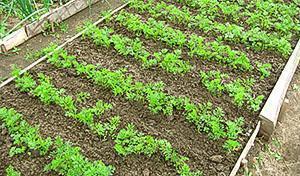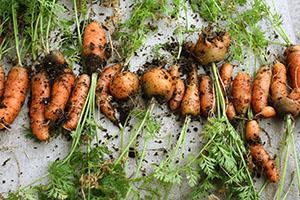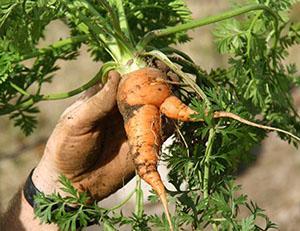How to grow good carrots in the country
 Not a single household plot can be imagined without tuft of feathery carrot leaves above the beds. This is one of the most sought after root crops. But even experienced gardeners sometimes cannot get a harvest of even large carrots, the cultivation and care of which, it would seem, have long been mastered. What are the reasons for failure, and how to grow good carrots?
Not a single household plot can be imagined without tuft of feathery carrot leaves above the beds. This is one of the most sought after root crops. But even experienced gardeners sometimes cannot get a harvest of even large carrots, the cultivation and care of which, it would seem, have long been mastered. What are the reasons for failure, and how to grow good carrots?
Choosing a site for carrots
How to grow carrots outdoors? A popular root crop requires attention not only when growing; taking care of the crop begins with choosing a site. Carrots, like all root crops, are very demanding on conditions, especially on the area in which the beds are broken.

- the introduction of fertilizers containing chlorine for crops;
- spring soil deoxidation;
- poor digging of beds, as well as clods, stones and large organic residues left in the soil;
- lack of lighting;
- excessively dry soil or excessive watering of carrots;
- excess nitrogen fertilizers;
- rough uneven weeding or thickened crops.
Moreover, many factors negatively affect both the appearance of root crops and their taste. Therefore, the area for carrots is chosen especially carefully. To get high-quality carrots, and planting and caring for them were not in vain:
- the soil should be light, loose and fertile;
- landings should not lack light;
- preparation for sowing begins in the fall.
Preparing the soil for carrots
Before the onset of cold weather, the soil is carefully dug up, roots and stones are removed. If necessary, add dolomite flour, lime, a complex of potash and phosphorus fertilizers. In the spring, the area for carrots is fertilized again and deeply loosened.
 Often, gardeners, sharing their experience on how to grow carrots in the open field, are advised to pay attention to crop rotation... It is good if zucchini or pumpkins, legumes, onions, potatoes or other nightshades grew in the garden before the carrots. If last season carrots, parsley or celery were already growing on the site, then this year the yield may decrease, and the crops may be exposed to carrot diseases or pests. It is possible to return the planting of carrots to their original place only after four years.
Often, gardeners, sharing their experience on how to grow carrots in the open field, are advised to pay attention to crop rotation... It is good if zucchini or pumpkins, legumes, onions, potatoes or other nightshades grew in the garden before the carrots. If last season carrots, parsley or celery were already growing on the site, then this year the yield may decrease, and the crops may be exposed to carrot diseases or pests. It is possible to return the planting of carrots to their original place only after four years.
Read also the article in the topic: feeding carrots in the open field in June!
Planting dates for carrots
 Sowing timing is no less important than the choice of the planting site. Wanting to grow good carrots as early as possible, summer residents try to use the frost resistance of the plant:
Sowing timing is no less important than the choice of the planting site. Wanting to grow good carrots as early as possible, summer residents try to use the frost resistance of the plant:
- Seeds begin to germinate already at + 3 ° C.
- Seedlings are not afraid of frosts down to –2 ° С.
- Well-developed plants tolerate frost down to –4 ° C.
- The optimal temperature regime is considered to be the range from 18-24 ° С.
- At temperatures above +25 ° C, the vegetation of carrots slows down.
And although the return cold has a negative effect on the shelf life of root crops, this does not prevent gardeners from leading, if the climate permits, pre-winter or spring sowing of carrots for an early harvest. For such crops, early ripe carrots are chosen.
Planting and caring for root crops intended for storage is carried out after a daytime temperature of about 15 ° C has been established.
Carrots planting and seedling care
Only high-quality seeds, carefully sorted and disinfected, can give a bountiful harvest.And to facilitate seeding, experienced summer residents offer several simple techniques.
 Carrot seeds:
Carrot seeds:
- mixed in equal proportions with washed dry sand;
- add to the seeds of rapidly germinating crops, for example, lettuce or radishes, in order to notice plantings as early as possible and carry out the first weeding;
- mixed with flour or starch paste, which is poured into the prepared furrows in a trickle;
- glued to narrow paper strips.
These measures, as well as pelleted seeds, make it easier to plant carrots, grow and care for the plantation, as thinning and weeding becomes less burdensome.
Before sowing, the beds are loosened to the depth of a bayonet, leveled, and moistened furrows 2 cm deep are prepared 25 cm apart. When the carrots are sown, the furrows are closed with a mixture of sand with peat or loose soil, and the plantings are covered with foil without watering.
Film:
- will not allow the moisture necessary for the seeds to evaporate;
- prevent an attack on seedlings of dangerous pests of carrots;
- will not allow a crust to form on the surface of the soil;
- will increase, which is important for early sowing, soil temperature and accelerate germination.
The film is removed only after the emergence of carrots, the cultivation and care of which now involves the regular loosening of the soil, watering and weeding the beds.
Care
 Answering the question: "How to grow carrots in the open field?", Experts always focus on the need to thin out the seedlings. But summer residents, at times, find it so difficult to part with only sprouts opening up leaves. As a result, the number of carrots grown is large, but its quality is not at all pleasing to summer residents.
Answering the question: "How to grow carrots in the open field?", Experts always focus on the need to thin out the seedlings. But summer residents, at times, find it so difficult to part with only sprouts opening up leaves. As a result, the number of carrots grown is large, but its quality is not at all pleasing to summer residents.
 To get a good harvest, you need to break the seedlings in a timely manner:
To get a good harvest, you need to break the seedlings in a timely manner:
- When the first pair of true leaves open on the seedlings, the carrots are subjected to the first thinning, leaving a gap of 3 cm.
- With two pairs of leaves, excess seedlings are again removed, leveling the formed holes.
Thinning is carried out after watering in the evening, so that the sun does not harm injured sprouts, and the smell of greenery does not attract carrot pests. The removed plants are pulled gently, without loosening in the ground.
A crust on the surface of the garden can become an obstacle to the growth of good carrots; after watering, it is regularly destroyed, carefully loosening the soil, or the soil is covered with peat mulch. So that the upper part of the growing and protruding root crops does not turn green, the carrots are spud from time to time.
Watering and feeding carrots
 The growing season for carrots is 4–5 months. In the first half of the term, the plant builds up a mass of greenery, requiring abundant glaze, and then the growth of a root crop begins, which negatively reacts to waterlogging.
The growing season for carrots is 4–5 months. In the first half of the term, the plant builds up a mass of greenery, requiring abundant glaze, and then the growth of a root crop begins, which negatively reacts to waterlogging.
- One square meter of young plants requires up to 4 liters of water three times a week.
- As the carrots grow, until the middle of the growing season, watering is increased.
- After two months, the carrots are watered once a week using 8-10 liters per square meter.
 When thinking about how to grow good carrots, we must not forget about protecting plants from pests. Also important is the prevention of carrot diseases, which can seriously affect the quality of the crop and its safety.
When thinking about how to grow good carrots, we must not forget about protecting plants from pests. Also important is the prevention of carrot diseases, which can seriously affect the quality of the crop and its safety.
Complex dressings for carrots are applied twice. The first is carried out a month after the emergence of sprouts, and the second two months later.